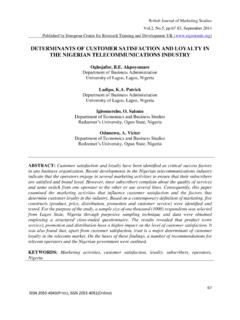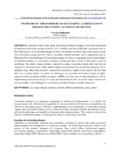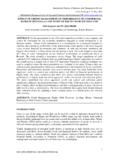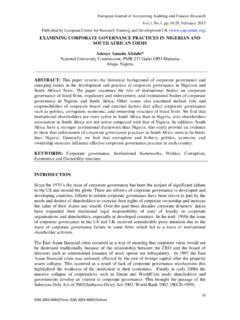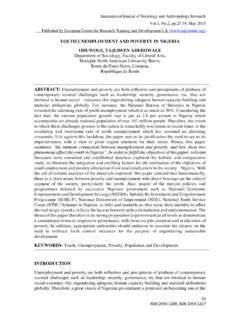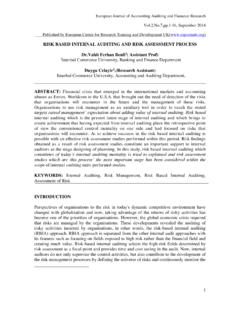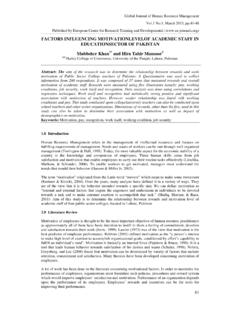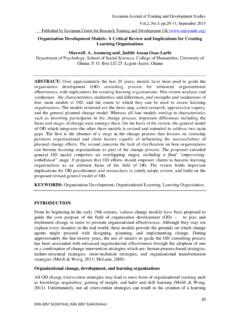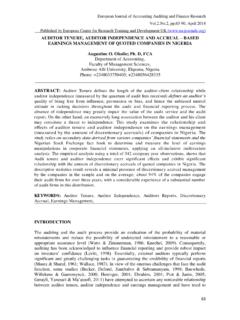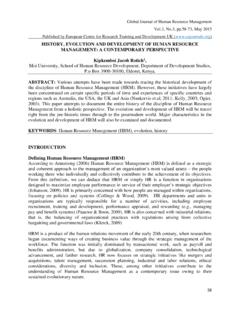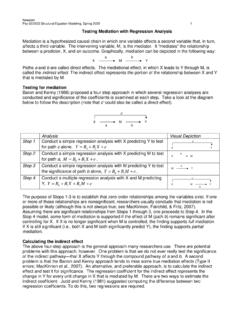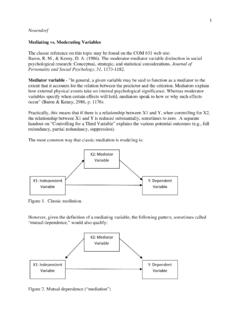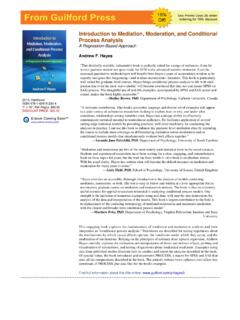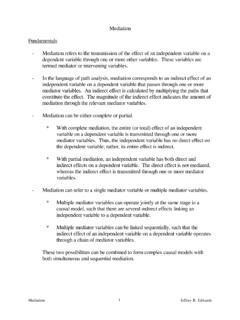Transcription of STATISTICAL MEDIATION ANALYSIS USING THE SOBEL TEST …
1 International Journal of Quantitative and Qualitative Research Methods , , , 2021 ISSN 2056-3620(Print) ISSN 2056-3639(Online) 42 STATISTICAL MEDIATION ANALYSIS USING THE SOBEL TEST AND HAYES SPSS PROCESS MACRO Soleman Abu-Bader School of Social Work, Howard University Tiffanie Victoria Jones School of Social Work, Grambling State University ABSTRACT: This paper aims to focus on the emerging practical application of mediational ANALYSIS in social science research practice.
2 Objectives: The paper introduces simple MEDIATION ANALYSIS to social science researchers discusses two STATISTICAL methods used to examine the effect of mediating variables on the relationship between the independent and dependent variables. These are the SOBEL test and bootstrapping USING Hayes Process Macro. The paper (1) defines and discusses the purpose of MEDIATION , (2) discusses conditions for MEDIATION , (3) presents research questions examined by MEDIATION , (4) outlines assumptions of MEDIATION ANALYSIS , (5) presents computer programs used in MEDIATION ANALYSIS , and (6) presents a detailed practical example illustrating how to conduct mediating ANALYSIS , read the results output, and write the results.
3 Implications: The paper concludes with a discussion on the implications of MEDIATION research for social science research and practice. KEYWORDS: MEDIATION , SOBEL test, bootstrap, process macro INTRODUCTION Examination of causal relationships provides understanding of the degree to which variation in the independent variable (X) results in change in a dependent variable (Y). Practically, it offers insight as to whether an intervention or treatment was successful or showed a hypothesized effect. However, few causal explanations exist between two variables alone, as X causes Y, or the X-Y relationship may be reciprocal.
4 Consequently, researchers may seek to examine the degree to which other variables contribute to the simple bivariate relationship between the independent and dependent variables, X and Y, respectively. These variables, sometimes called extraneous variables, intervening variables, covariates, or process variables, offer a more complex and deeper understanding of the relationship between X and Y. Wegener and Fabrigar (2000) describe three types of intervening variables for causal hypotheses: (1) direct causal effect, (2) mediated causal effect, and (3) moderated causal effect. Mediators and moderators are often confused and used interchangeably International Journal of Quantitative and Qualitative Research Methods , , , 2021 ISSN 2056-3620(Print) ISSN 2056-3639(Online) 43 (Baron and Kenny 1986; Wu and Zumbo 2008).
5 However, as Baron and Kenny (1986) report, they are distinct conceptually, strategically, and statistically. While moderators strengthen the relationship between independent and dependent variables, mediators intervene between the independent and dependent variables. Mediators, labeled as M , create an indirect relationship by linking the two variables, X and Y, which helps to explain the process of the relationship. These variables essentially refine a causal relationship by explaining why and how a cause leads to an outcome (Baron and Kenny 1986; Frazier et al. 2004; Wu and Zumbo 2008). This paper focuses on the emerging practical application of mediational ANALYSIS in social science research practice.
6 First, the paper discusses mediating variables and their use, research questions examined by MEDIATION ANALYSIS , and then presents two useful STATISTICAL methods for analyzing mediating relationships: SOBEL test ( SOBEL 1982) and Hayes SPSS Process Macro (Hayes 2013). The paper also discusses the underlying assumptions for USING these analyses. Lastly, a practical example is provided, which illustrates how to compute the analyses and how to interpret the output. LITERATURE/THEORETICAL UNDERPINNING The origins of MEDIATION ANALYSIS date as far back as 1920 with Sewall Wright s method of ANALYSIS by path coefficients in which he proposed indirect and direct causal relationships for the genetically-derived color variations in guinea pigs (Wright 1920).
7 He described MEDIATION as product of coefficients. Eight years later, Woodworth presented the Stimulus Organism Response (SOR) theory, which posits that different mediating mechanisms functioning within an organism intervene between the stimulus and the response (Woodworth 1928). As illustrated by these seminal works, mediating variables intervene between or mediate the relationship between the independent and dependent variables. The value of mediating variables cannot be overstated. As noted, mediating variables are foundational for understanding mechanisms of effects. Additionally, mediating processes underpin many fields, including theory testing for intervention science, applied research related to prevention and treatment, and development of psychological theories, particularly behavioral psychology (MacKinnon, Fairchild, and Fritz 2007).
8 This third application may be most relevant when discussing full or partial MEDIATION . Specifically, the observation of partial MEDIATION offers clear implications for empirically testing other indirect effects that are operating (Rucker et al. 2011). This naturally lends itself to further theoretical development. Furthermore, while mediators have proven useful for theory development in the field of psychology, as we later discuss, we submit for consideration that these unique variables have strong application in other social science fields, such as social work and sociology.
9 International Journal of Quantitative and Qualitative Research Methods , , , 2021 ISSN 2056-3620(Print) ISSN 2056-3639(Online) 44 MEDIATION Purpose of Mediators MEDIATION is an extension of simple linear regression in that it adds one or more variables to the regression equation. Mediating variables describe the way in which an intervention yields its outcome. Simply defined, mediating variables are mechanism through which X [independent variable] influences Y [dependent variable] (Hayes 2013:7).
10 In MEDIATION ANALYSIS , researchers assume that the independent variable (X) affects the mediator (M), which in turn, affects the dependent variable (Y). In other words, the relationship between the independent and dependent variable is assumed to be indirect. Figure 1 is a simple MEDIATION model illustrating the relationship between X, M, and Y. Figure 1: Simple MEDIATION Model Effect of X on Y The relationship between the independent (X) and dependent (Y) variables may be direct or indirect. Direct effect occurs when the relationship between X and Y cannot be influenced by a third (or fourth) variable.
